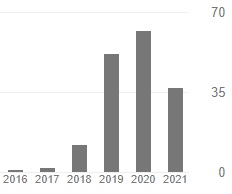Penerapan Pembelajaran Problem Based Learning Berbasis Blended Learning terhadap Hasil Belajar Kognitif dan Motivasi Mahasiswa
Abstract
Full Text:
PDFReferences
Arends, R. (2008). Learning to Teach. Penerjemah: Helly P dan Sri M. New York: McGraw Hill Company.
Borg, W., & Gall, M. (1983). Educational Research an Introduction. New York and London: Logman
Facione, P. (2013). Critical Thinking: What It Is and Why It Counts. California: Measured Reason and The California Academic Press.
Fry, H., Steve, K., & Stephanie, M. (2009). The Handbook for Teaching and Learning in Higher Education. New York dan London: Routledge.
Kintul, M. K., Zhu, C., & Edmond, K. (2017). Blended learning effectiveness: the relationship between student characteristics, design features and outcomes. International Journal of Educational Technology in Higher Education, 14 (7), hlm. 2-20.
Kistow, B. (2011). Blended learning in higher education: A study of a graduate school of business, Trinidad and Tobago. Caribbean Teaching Scholar, 1 (2), hlm. 115-128.
Munasir & Anshori, S. (2010). Pengintegrasian Problem Bassed Learning dan Pendekatan Group Investigation. Jurnal Kependidikan Interaksi, 5 (5), hlm. 1-9.
National Science Teachers Association. 2006. Induction Programs for the Support and Development of Beginning Teachers
Ngana, O., Tangb, T., Chanc, A., Daisy, M., & Mei K. (2017). Blended Learning in Anatomy Teaching for Non-Medical Students: An Innovative Approach to the Health Professions Education. Journal Health Professions Education, 4 (1), hlm. 149-158.
Perez, V., Lopez, M., & Lazoro, R. (2011). Blended learning in higher education: Students perceptions and their relation to outcomes. Journal Computers and Education, 56 (1), hlm. 818-826.
Ramakrisnana, P., Yahya, Y., M. Nor, H., & Azlan. (2012). Blended Learning: A Suitable Framework For E-Learning In Higher Education. Procedia - Social and Behavioral Sciences. The 3rd International Conference on e-Learning ICEL 2011 (hlm. 513-526) Bandung: UPI
Sailah, I., Tresna, D. K., I Made, S., SP Mursid., Endrotomo., Sylvi, D., Syamsul, A., Liliana S., Ludfi, D., Jumhur., Sri P., Lien, H., Henny, K., Emmy, H., Ridwan, R. T., Evawany & Nafiron, M. (2014). Buku Kurikulum Pendidikan Tinggi. Jakarta: Direktorat Pembelajaran dan Kemahasiswaan, Direktorat Jendral Pendidikan Tinggi, Kementrian Pendidikan dan Kebudayaan
Sarıtepeci, M., & Cakir, H. (2015). The Effect of Blended Learning Environments on Student's Academic Achievement and Student Engagement: A Study on Social Studies Course. Journal Education and Science, 4 (177), hlm. 203-216.
Savery, J., & Duffy, T. (2001). Problem Based Learning: An instructional model and its constructivist framework. CRLT Technical Report, 16 (01), hlm. 77-81.
Savery, J. (2006). Overview of Problem-based Learning: Definitions and Distinctions. The Interdisciplinary Journal of Problem-based Learning, 1 (1), hlm. 9-20.
Schunk, D. (2012). Learning Theories An Educational Perspective. Boston: Pearson Education, Inc.
Semerci, N. (2006). The Effect of Problem-Based Learning on The Critical Thinking of Students In The Intellectual and Ethical Development Unit.
Slavin, R. (2006). Educational Psycology: Theory and Practice. Boston: Pearson Education, Inc.
Simone. (2014). Problem-Based Learning in Teacher Education. International Journal of Humanities and Social Science, 4 (12), hlm. 54-62
Sudarman. (2007). Problem Based Learning: Model Pembelajaran untuk Mengem-bangkan dan Meningkatkan Kemampuan Memecahkan Masalah. Jurnal Pendidikan Inovatif, 2 (2), hlm. 68-73.
Suwono, H. (2013). Aktivitas belajar mahasiswa calon guru Melalui penerapan Blended Learning Menggunakan website berbasis moodle. Prosiding Seminar Nasional Biologi IPA 2013 (hlm.153-160. Surabaya: UNESA.
Yamin. (2006). Strategi Pembelajaran Berbasis Kompetensi. Jakarta : Gaung Persada Pers
Yustina. (2016). Pemikiran Kreatif dan Pemahaman Konsep Mahasiswa Pendidikan Biologi dalam Pembelajaran IPA Melalui Problem Based Learning (PBL). Prosiding SEMIRATA Bidang MIPA 2016 (hlm. 231-233) Palembang: UNSRI.
DOI: https://doi.org/10.24114/jpb.v7i3.10433
Article Metrics
Abstract view : 1085 timesPDF - 784 times
Refbacks
- There are currently no refbacks.
............................................................................................................................................................................................................................................................................................................................

Jurnal Pendidikan Biologi: Journal of Biology Education by Department of Biology Education, Program Pascasarjana, Universitas Negeri Medan. Dikelola oleh Jurnal Universitas Negeri Medan is licensed under a Creative Commons Attribution 4.0 International License. p-ISSN (Print) 2086-2245 | e-ISSN (Online) 2502-3810

